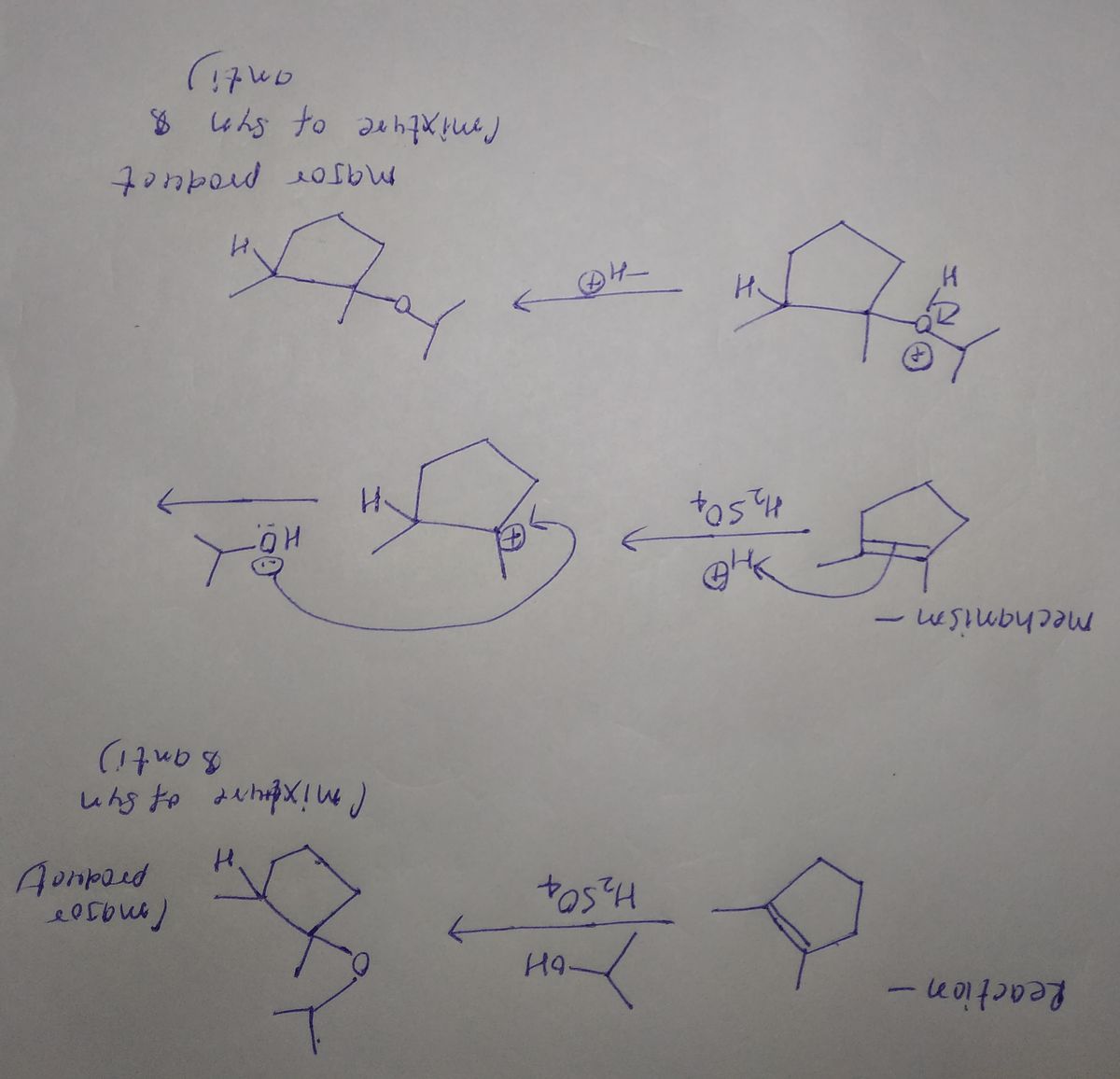Chemistry
10th Edition
ISBN:9781305957404
Author:Steven S. Zumdahl, Susan A. Zumdahl, Donald J. DeCoste
Publisher:Steven S. Zumdahl, Susan A. Zumdahl, Donald J. DeCoste
Chapter1: Chemical Foundations
Section: Chapter Questions
Problem 1RQ: Define and explain the differences between the following terms. a. law and theory b. theory and...
Related questions
Question

Transcribed Image Text:### Educational Content: Understanding the Major Product of an Organic Reaction
**Question:**
What is the major product of the following reaction?
**Reaction Details:**
- **Reactants:**
- A cyclopentene derivative
- Isopropanol (CH₃CHOHCH₃) with sulfuric acid (H₂SO₄) as a catalyst
- **Reaction Mechanism:**
- The reaction involves the opening of a double bond in the cyclopentene derivative and the addition of an isopropyl group.
**Product Options:**
1. **Option 1:**
- Structure: A cyclopentane ring with an isopropoxy group attached, indicating an SN1 or SN2 type reaction.
- Stereochemistry: Shows a specific orientation with a hydrogen atom at a chiral center.
2. **Option 2:**
- Structure: A different orientation of the cyclopentane ring with an isopropoxy group.
- Stereochemistry: Noted as a "mixture of syn and anti," suggesting that the reaction may lead to multiple stereoisomers due to different possible configurations around the chiral center created in the reaction.
**Graph/Diagram Explanation:**
- The diagrams depict the structural formulas of the reactants and potential products.
- The product options indicate possible outcomes based on stereochemistry, highlighting the role of chirality and possible stereoisomers in the reaction.
### Key Concepts:
- **Stereochemistry:** Understanding the 3D arrangement of atoms is vital to predicting reaction products.
- **Reaction Mechanisms:** SN1 and SN2 mechanisms can influence the product structure and stereochemistry.
- **Catalysts in Reactions:** The use of sulfuric acid (H₂SO₄) suggests an acid-catalyzed process, potentially influencing the reaction pathway.
This content is meant to aid students in recognizing reaction mechanisms and predicting major products in organic chemistry.
Expert Solution
Step 1
B 
Step by step
Solved in 2 steps with 1 images

Recommended textbooks for you

Chemistry
Chemistry
ISBN:
9781305957404
Author:
Steven S. Zumdahl, Susan A. Zumdahl, Donald J. DeCoste
Publisher:
Cengage Learning

Chemistry
Chemistry
ISBN:
9781259911156
Author:
Raymond Chang Dr., Jason Overby Professor
Publisher:
McGraw-Hill Education

Principles of Instrumental Analysis
Chemistry
ISBN:
9781305577213
Author:
Douglas A. Skoog, F. James Holler, Stanley R. Crouch
Publisher:
Cengage Learning

Chemistry
Chemistry
ISBN:
9781305957404
Author:
Steven S. Zumdahl, Susan A. Zumdahl, Donald J. DeCoste
Publisher:
Cengage Learning

Chemistry
Chemistry
ISBN:
9781259911156
Author:
Raymond Chang Dr., Jason Overby Professor
Publisher:
McGraw-Hill Education

Principles of Instrumental Analysis
Chemistry
ISBN:
9781305577213
Author:
Douglas A. Skoog, F. James Holler, Stanley R. Crouch
Publisher:
Cengage Learning

Organic Chemistry
Chemistry
ISBN:
9780078021558
Author:
Janice Gorzynski Smith Dr.
Publisher:
McGraw-Hill Education

Chemistry: Principles and Reactions
Chemistry
ISBN:
9781305079373
Author:
William L. Masterton, Cecile N. Hurley
Publisher:
Cengage Learning

Elementary Principles of Chemical Processes, Bind…
Chemistry
ISBN:
9781118431221
Author:
Richard M. Felder, Ronald W. Rousseau, Lisa G. Bullard
Publisher:
WILEY